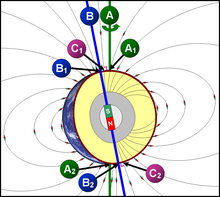
A geographical pole or geographic pole is either of the two points on Earth where its axis of rotation intersects its surface.[1] The North Pole lies in the Arctic Ocean while the South Pole is in Antarctica. North and South poles are also defined for other planets or satellites in the Solar System, with a North pole being on the same side of the invariable plane as Earth's North pole.[2]
Relative to Earth's surface, the geographic poles move by a few metres over periods of a few years.[3] This is a combination of Chandler wobble, a free oscillation with a period of about 433 days; an annual motion responding to seasonal movements of air and water masses; and an irregular drift towards the 80th west meridian.[4] As cartography requires exact and unchanging coordinates, the averaged[citation needed] locations of geographical poles are taken as fixed cartographic poles and become the points where the body's great circles of longitude intersect.
YouTube Encyclopedic
-
1/3Views:14 0573 10721 122
-
Working of Compass | Earth as Magnet | Magnetic & Geographic Poles (NCERT Class 6 Chapter 13 | NSO)
-
Why Is The North Pole Also The South Pole?
-
DIFFERENT EQUATOR, POLE & AXIS // Part -2// Lesson- 22// By- SS Ojha Sir
Transcription
See also
References
- ^ Kotlyakov, Vladimir; Komarova, Anna (2006). "pole; geographic pole". Elsevier's dictionary of geography : in English, Russian, French, Spanish and German (1st ed.). Elsevier. p. 557. ISBN 9780080488783. Retrieved 22 June 2015.
- ^ Archinal, B. A.; A’Hearn, M. F.; Bowell, E.; Conrad, A.; Consolmagno, G. J.; Courtin, R.; Fukushima, T.; Hestroffer, D.; Hilton, J. L.; Krasinsky, G. A.; Neumann, G.; Oberst, J.; Seidelmann, P. K.; Stooke, P.; Tholen, D. J.; Thomas, P. C.; Williams, I. P. (February 2011). "Report of the IAU Working Group on Cartographic Coordinates and Rotational Elements: 2009". Celestial Mechanics and Dynamical Astronomy. 109 (2): 101–135. Bibcode:2011CeMDA.109..101A. doi:10.1007/s10569-010-9320-4. S2CID 189842666.
- ^ Lovett, Richard A. (14 May 2013). "Climate change has shifted the locations of Earth's North and South Poles". Scientific American. Retrieved 6 January 2019.
- ^ "Polar motion". International Earth Rotation and Reference Systems Service. Federal Agency for Cartography and Geodesy. 2013. Retrieved 22 October 2020.
